By Tal Beeri and Yaakov Lappin, ALMA REC 9 January 2024
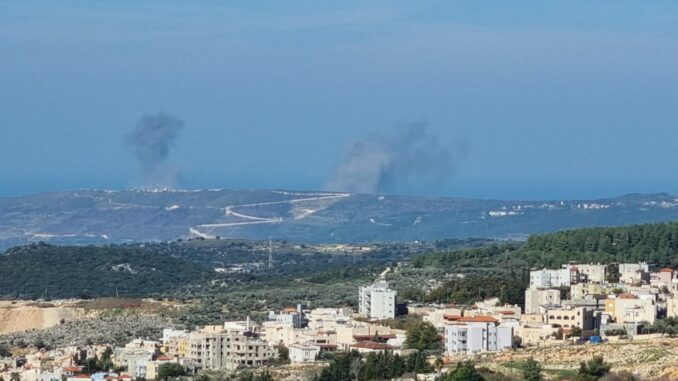
There have been an increasing number of Lebanese and international media reports in recent days and weeks about efforts to forge a diplomatic agreement between Israel and Hezbollah, spearheaded by the United States and France. This would ostensibly be done by pushing Hezbollah operatives back from the border with Israel by a distance of between five and ten kilometers.
The Lebanese, for their part, are already issuing statements that, within the framework of the arrangement, they will not give up any territory in several disputed border points, including the northern half of the village of Ghajar (which is entirely populated by Israeli citizens). Moreover, the Lebanese are listing demands designed to limit IDF activity, especially its aerial activity, and they link the ceasefire to the condition that the IDF does not operate in Syria (against targets of the Shiite axis).
The Lebanese/Hezbollah Border Claims:
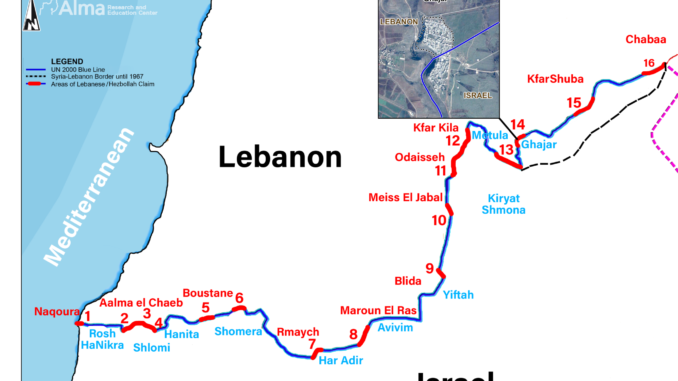
According to several reports, the French, who have interests that are not necessarily aligned with the interests of Israel, are leading an additional initiative in which, as part of the arrangement, an economic support plan for Lebanon will be implemented, solving the economic crisis and receiving Arab and Western funding. In addition, outstanding issues in Lebanon would be resolved, such as the election of a new president and the appointment of a commander for the Lebanese Armed Forces.
We wish to clarify: Hezbollah has no real intention of practically withdrawing from the border, and the elements of the Lebanese government, which constitute the formal body with which the negotiations are conducted, have no real ability to influence Hezbollah’s decision-making.
Hezbollah’s military infrastructure in southern Lebanon is based on the ‘Resistance Society’ concept in southern Lebanon. To push back the operatives and Hezbollah’s military infrastructure from the border with Israel, the Shi’ite villages, where many Hezbollah operatives reside and where the military infrastructure is based, would need to be physically moved and distanced. Of course, such a removal is not possible.
A diplomatic arrangement will not separate the military infrastructure from the civilian infrastructure.
The negotiations constitute a delusional process since the proposed “solution” of a tactical withdrawal from the border is cosmetic and does not address Hezbollah’s significant core military capabilities spread throughout Lebanon, which have been a blatant violation of UN Security Council Resolutions 1701 and 1559 for many years, not to mention an intolerable threat to northern Israel.
Just as there is currently no one who can enforce Resolution 1701, there will be no one to enforce the new arrangement. Neither a new international force nor a reinforcement of UNIFIL would be up for doing the job.. Anyone relying on the Lebanese army will be bitterly disappointed. Demography is gradually and naturally turning the Lebanese army into more and more of a Hezbollah proxy.
We estimate that ultimately, even if Israel makes concessions, it will actually receive nothing other than a sham. All this for an illusory peace that pacifies Israel, just as Hezbollah wants.
In the (not too distant) future, Hezbollah would, under these circumstances, attack at a place and time convenient for it, as it had already planned to and was ready to do before October 7, 2023.
In this situation, the initiative will remain in the hands of Hezbollah.
What are Hezbollah’s core military capabilities?
Hezbollah’s ATGM (Anti-Tank Guided Missile) array consists of very advanced missiles with a range of up to 10 km (upgraded Kornet, likely the type used to hit the military base on Mount Meron on January 6, and were fired, in our estimation, based on a terrain analysis we conducted, from a minimum range of 8600 meters), deployed across all 200 Shi’ite villages in the area south of the Zahrani River in southern Lebanon, especially in the area south of the Litani River, and up to the border with Israel.
These areas are part of Hezbollah’s military infrastructure and are part of what Hezbollah calls the ‘Southern Regional Defense Plan’
This so-called ‘defense’ plan is actually based on two lines. The first stretches from the Israeli border to the Litani River. The second stretches from the north of the Litani River to the Zahrani River. The capabilities embedded in the first defense line are, in fact, highly offensive and are based on firepower, which we have seen directed toward northern Israel starting on October 8.
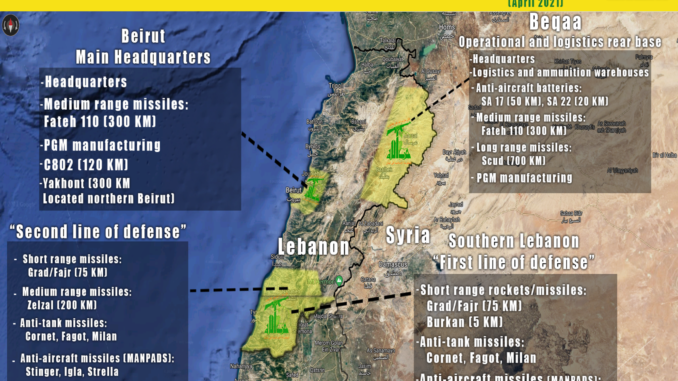
Hezbollah has embedded launchers and a large number of rockets and missiles throughout southern Lebanon to threaten Israeli territory. South of the Litani River, there are many Grad rocket launchers with a strike range of 45 kilometers, Burkan rockets with massive warheads and a strike range of up to 10 kilometers, and an air defense system with shoulder-fired ground-to-air missiles and even surface-to-air missile batteries.
In addition, throughout southern Lebanon, there are many Hezbollah underground infrastructures, such as bunkers and various types of tunnels, and a huge number of houses in southern Lebanon—one out of every three—are used militarily by Hezbollah. In every Shi’ite village in southern Lebanon and also around these villages, Hezbollah’s military activity takes place. Among other things, there is a kind of local civil-political mechanism – the Rabat, or Liaison, which allows Hezbollah to control what happens throughout each and every village in the south of the country and to deploy forces and weapons as needed.
Hezbollah will launch missiles toward civilian communities within Israel and toward IDF forces from homes in the villages and areas adjacent to them using the civilian environment as a human shield. Given all this, in addition to the fact that there will not really be a tactical withdrawal of Hezbollah operatives from the border area, there is also neglect of Hezbollah’s core military capabilities in southern Lebanon, south of the Litani River.
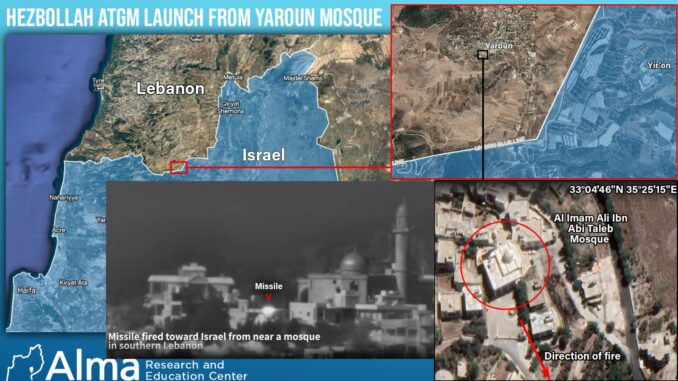
The IDF has carried out over 600 attacks in Lebanon since October 7. The extent of the losses and damage to Hezbollah is over 150 operatives killed (we estimate that five percent of them were killed in Syria) and many dozens in total of destroyed readiness positions (some may be empty), combat collection systems (observation means), underground systems (possibly storage places, connecting tunnels, approaching, etc.), observation posts (some may be empty and without means), launch sites (usually referring to places from which rockets, mortars, and ATGMs were or were expected to be launched), ammunition warehouses, and air defense targets.
In addition, in our estimation, only a few sensitive sites (in terms of means and advanced capabilities) were attacked. For example, according to reports in Lebanon, an aerial attack was carried out in the area of the village of Bouslaiya in Jabal Safi on the night of December 21. This is an exceptional attack, about 50 kilometers north of the border with Israel. As we stated in a publication in July 2021, Jabal Safi is located above an underground infrastructure route with a strategic Hezbollah tunnel that we exposed. The underground route and these strategic tunnels of Hezbollah also serve as a base for military infrastructure such as underground ballistic missile pits (such as for Fatah 110 missiles) and others.
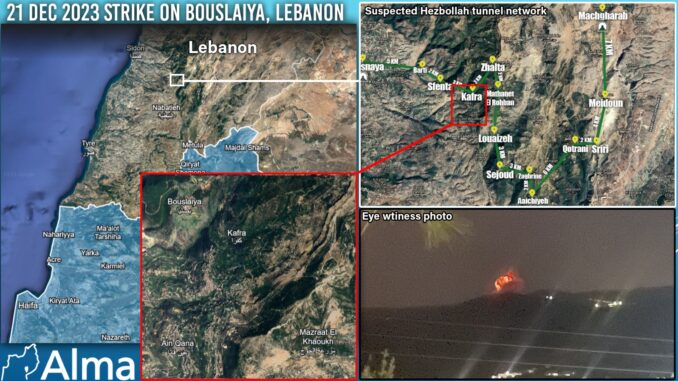
As of the writing of these lines, we still maintain the claim that the extent of the IDF’s attacks against Hezbollah so far does not constitute a significant blow to Hezbollah’s capabilities. The above does not constitute a serious blow to Hezbollah, and there is no real damage to the readiness of its various systems, with an emphasis on the main arrays, such as the fire array (rockets and ATGMs) and the elite Radwan Unit.
To our understanding, most of the Hezbollah operatives killed are not from the Radwan unit but come from Hezbollah’s geographical units in southern Lebanon. We estimate that between a quarter and a third of the dead belong to the Radwan unit.
It is true that the January 8th assassination of Wassam Hassan al-Tawil (Hajj Jawad), who apparently served as the commander of the Radwan unit, is a blow to morale, but from an operational point of view, we do not know how to assess at this stage if there will be any damage to the unit’s competence. In any case, if there is, then, in our estimation, it will be for the short term only.
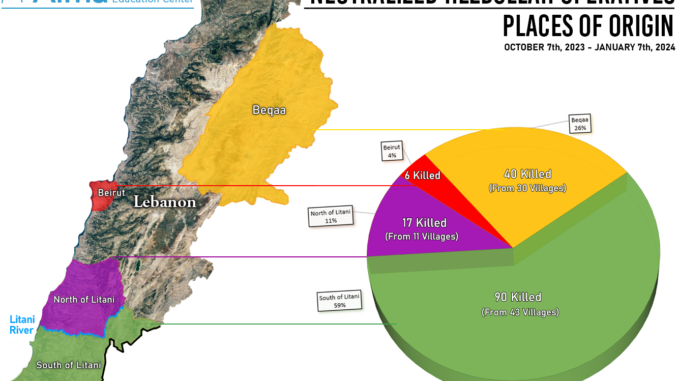
Even if we assume that all the killed operatives are from the Radwan unit, this does not affect its operational capability at this stage. The geographical location of the Radwan operatives does not affect the unit’s readiness to infiltrate the Galilee. It is important to remember that this is a central purpose of the unit, even if its operatives have retreated to a rear line (the Litani River, for example). This does not affect their preparedness, organization, or ability to set out for action.
As far as we understand, the damage to the ATGM array (a central threat) is marginal (damage to several ATGM cells does not affect an array in which there are many thousands of missiles and extensive redundancy of operation). Also, in our estimation, the air unit (127), which operates the UAV array (with an emphasis on the suicide/attack UAVs), was not damaged at all.
Another example is the Burkan rocket array. In our estimation, Hezbollah has thousands of rockets of this type. According to public reports, the IDF attacked Burkan rocket warehouses only a few times. Even if the destruction of hundreds of rockets of this type that were in these warehouses occurred, Hezbollah still has thousands more of these rockets.
The amount of weapons and the extent of the deployment of Hezbollah’s military sites in Lebanon is unprecedented, large, and widespread, spanning the country.
Therefore, at any given moment, in line with a decision, Hezbollah can activate its rocket fire array and its missiles against Israel in very large numbers and from all over Lebanon. This, with an emphasis on the strategic systems that have not been deployed south of the Litani River.
Appendix
UN Security Council Resolution 1559, passed in 2004, calls for the disbanding and disarmament of all Lebanese and non-Lebanese militias and supports the extension of the control of the Government of Lebanon over all Lebanese territory.
UN Security Council Resolution 1701, passed in 2006, establishes that the area between the Blue Line (the Israeli-Lebanese border) and the Litani River must be free of any armed personnel, assets, and weapons other than those of the Government of Lebanon and UNIFIL.



How do you distinguish between Lebanese army and Hezbollah. Since Hezbollah is part of the Lebanese government, there is no way to reach a plausible agreement.